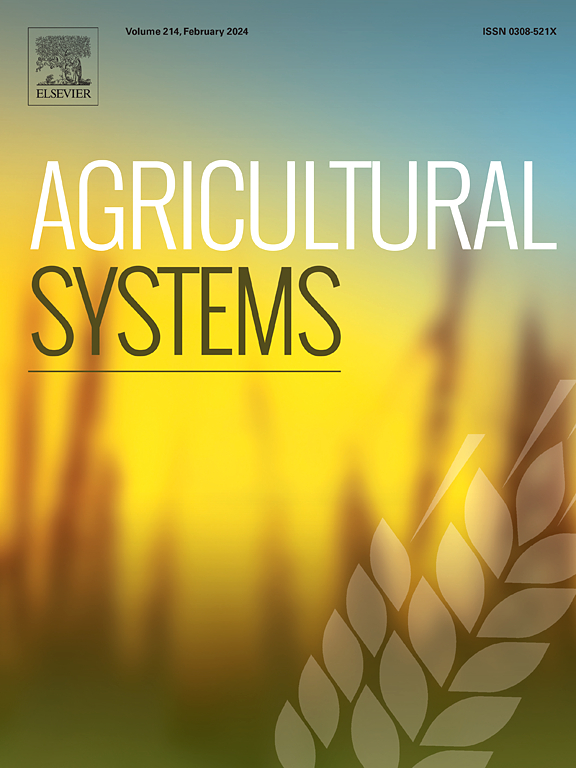Lessons learned from a detailed exploration of APEX as a tool to represent corn residue management and cover crops
IF 6.1
1区 农林科学
Q1 AGRICULTURE, MULTIDISCIPLINARY
引用次数: 0
Abstract
CONTEXT
Agricultural management practices to improve the regulation of water, sediments, or nutrients, make farming decisions and operations more complex. This extra complexity often stems from the use of multiple species and farm heterogeneity so that species can complement each other, and different fields (and the space between fields) can provide alternative benefits, like biomass or nutrient regulation. Mechanistic crop and farm models provide tools to explore the effect of these practices.
OBJECTIVE
The study goal was to assess the capability of a mechanistic crop model (the Agricultural Policy/Environmental eXtender Model, APEX) to represent the impacts of cover crops and corn residue on plant growth, water, erosion, and nutrient flow.
METHODS
Using Southern Ontario conditions, a simplistic corn–cover crop rotation strategy was implemented using APEX and hundreds of variables dynamically updated by the model were analyzed. The model's documentation and source code were analyzed to understand the connections among the variables.
RESULTS AND CONCLUSIONS
The model reproduced corn and cover crop growth patterns observed in Southern Ontario and the positive effects of cover crops and residue on water, sediments, and nutrient control. The model suggested that these practices generate important differences in nutrient dynamics and patterns of vertical accumulation of soil nutrients. Issues with the model are reported and ways to avoid them discussed. There were inconsistencies and unrealistic responses in the outputs when simulating two crops growing together or multiple fields, including small mass balance discrepancies, which —in complex numerical models like APEX— can generate hard-to-track differences and may be amplified when multiple fields are simulated over several years. Users should be aware of these limitations when assessing the role of diversified farming practices.
SIGNIFICANCE
The results highlight the importance of carefully reviewing the internal consistency of mechanistic models beyond validating a few key outputs, especially when the intended use of a model is to extrapolate the impacts to novel conditions or to infer processes not directly validated. These findings could open the conversation for more robust modelling and validating approaches when using crop models.

从APEX作为代表玉米残留管理和覆盖作物的工具的详细探索中获得的经验教训
农业管理实践旨在改善对水、沉积物或养分的调节,使农业决策和经营更加复杂。这种额外的复杂性通常源于多物种的使用和农场的异质性,以便物种可以相互补充,不同的领域(以及领域之间的空间)可以提供替代的好处,如生物量或营养调节。机械作物和农场模型为探索这些做法的效果提供了工具。本研究的目的是评估一个机械作物模型(农业政策/环境扩展模型,APEX)对覆盖作物和玉米秸秆对植物生长、水分、侵蚀和养分流动的影响的能力。方法以安大略省南部地区为研究对象,采用APEX模型对玉米覆盖作物轮作策略进行简化,并对模型动态更新的数百个变量进行分析。分析模型的文档和源代码,以了解变量之间的联系。结果与结论该模型再现了在南安大略省观测到的玉米和覆盖作物的生长模式,以及覆盖作物和秸秆对水分、沉积物和养分控制的积极影响。该模型表明,这些做法在养分动态和土壤养分垂直积累模式上产生了重要差异。报告了模型存在的问题,并讨论了避免这些问题的方法。在模拟两种作物一起生长或多块田地时,在输出中存在不一致和不现实的反应,包括小的质量平衡差异,这在像APEX这样复杂的数值模型中会产生难以跟踪的差异,并且在数年模拟多块田地时可能会被放大。在评估多样化耕作方式的作用时,使用者应意识到这些限制。结果强调了仔细审查机制模型内部一致性的重要性,而不是验证几个关键输出,特别是当模型的预期用途是推断对新条件的影响或推断未直接验证的过程时。这些发现可以为使用作物模型时更稳健的建模和验证方法开启对话。
本文章由计算机程序翻译,如有差异,请以英文原文为准。
求助全文
约1分钟内获得全文
求助全文
来源期刊

Agricultural Systems
农林科学-农业综合
CiteScore
13.30
自引率
7.60%
发文量
174
审稿时长
30 days
期刊介绍:
Agricultural Systems is an international journal that deals with interactions - among the components of agricultural systems, among hierarchical levels of agricultural systems, between agricultural and other land use systems, and between agricultural systems and their natural, social and economic environments.
The scope includes the development and application of systems analysis methodologies in the following areas:
Systems approaches in the sustainable intensification of agriculture; pathways for sustainable intensification; crop-livestock integration; farm-level resource allocation; quantification of benefits and trade-offs at farm to landscape levels; integrative, participatory and dynamic modelling approaches for qualitative and quantitative assessments of agricultural systems and decision making;
The interactions between agricultural and non-agricultural landscapes; the multiple services of agricultural systems; food security and the environment;
Global change and adaptation science; transformational adaptations as driven by changes in climate, policy, values and attitudes influencing the design of farming systems;
Development and application of farming systems design tools and methods for impact, scenario and case study analysis; managing the complexities of dynamic agricultural systems; innovation systems and multi stakeholder arrangements that support or promote change and (or) inform policy decisions.
 求助内容:
求助内容: 应助结果提醒方式:
应助结果提醒方式:


